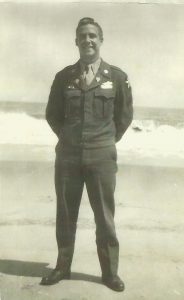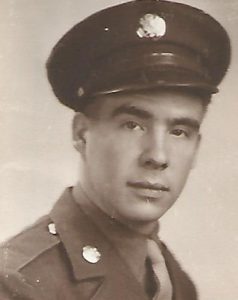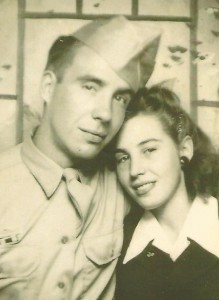“If you love me, you won’t leave.”
Ken Lewis’ mother screamed at him from the front door as he as he left his Meriden, Connecticut, home to enlist in the U.S. Army. Two weeks later, July 14, 1944, he was on a troop train bound for Camp Blanding, Florida, and 17 weeks of infantry training. He was 21 years old.
Countless mothers, just like Edith Lewis, were left standing on their porches. They wept for the young men who left home to fight in World War II. Many wouldn’t return, but the ones who did would go on to be known as “The Greatest Generation,” a label coined by journalist Tom Brokaw to describe the American men and women who were raised in the Great Depression, fought in WWII and put their lives, and the country, back together for their children and grandchildren.
Now, at 92 with a thick gray mustache, Ken sinks into the recliner at his assisted living apartment in Abilene. Looking through large round glasses, he leans forward, eyebrows raised high, recalling events with specific details, dates and times. Seven and half months overseas engraved memories that have endured a lifetime.
He’d left behind his mother without her only son with a recently completed associate degree in poultry science. The farmer he had been working for desperately begged him to stay.
“He promised to immediately deed his farm to me because he had no close living relatives if I would not go into military service,” Ken said. “I explained to him that I would never be able to live with myself if I failed to serve my country.”
One of his eight grandchildren, Patrick Lewis, recalls the same farm story, admiring his grandfather’s sense of duty. “Everyone gave up something, but that was really all he had, and he gave it up.”
On Dec. 2, 1944, almost three years after the attack on Pearl Harbor, Ken boarded one of the 52 ships that made up a small convoy headed for Europe. Troops were double-loaded. Every 12 hours the soldiers above deck would switch with those below.
On Dec. 16, 1944, he walked ashore French soil for the first time and became a member of the 2nd squad, 2nd platoon, George Company, 2nd battalion, 109th Infantry Regt., 28th Infantry Division.
For 17 weeks he and his division trained for the Pacific Theater to become effective jungle fighters in Japan. Instead, they were sent to Europe as replacements. Finding themselves in knee-deep snow, everyone quickly discarded their oversized jungle packs of tropical clothing.
“We saw snow from the time we got there until Easter Sunday “” even then you could still see some underneath the evergreen trees,” he said.
One of Ken’s three battle stars pinned on his European Theater ribbon represents the largest land battle the U.S. ever fought, the Battle of the Bulge. Eighty thousand Americans were left dead, wounded or captured. Historian Stephen E. Ambrose wrote that the battle began with snow during the coldest winter in Europe in 38 years.
Ken remembers the day the gray sky eventually cleared enough to allow the planes of the 8th Air Force to attack.
“They came screaming down upon enemy forces like a swarm of angry hornets, strafing and bombing the enemy columns as they headed east, back to the Fatherland,” he said. By Jan. 31, 1945, the enemy was driven back to its original line of departure.
Morley Cassidy, journalist and war correspondent who traveled with the troops through the Battle of the Bulge and their subsequent drive into the Rhineland, told the story. His voice crackled in a nation-wide broadcast to America, “The 28th Division has performed one of the greatest feats in the history of the American Army. Against nine divisions it has held so firmly that the German timetable has been thrown off completely.”
Germany surrendered on May 8, 1945. Japan would follow suit a few months later on Aug. 14. The war was over, but the world had only just begun to put their lives back together.
Even though the war had ended in Europe, Lewis’ division was “occupationed” in Germany until July.
“It means occupying enemy territory,” he said. “We’d go into towns, not cities. They’d send a jeep out with microphones, in German of course, telling the people they had 20 minutes to vacate and assemble in a field so that we could search their property.”
Reconstruction was as critical in the U.S. as it was in Europe. Unlike wars today, most civilians played a role in the war effort. They lived through food rations, organized metal and rubber drives, worked in defense plants and even trained as coastal airplane spotters. Those who learned resourcefulness during the Great Depression carried it over to wartime and the battlefield. Their resilience sustained as soldiers returned to civilian life. Together, they strived to recreate the lives they knew before the war.
Ken sailed home to Connecticut. He married his wife of 68 years, Linda, and like others who contributed to the baby boom, they had four sons. Ken went immediately back into agriculture, starting as a milk deliveryman for a dairy farm and then moved on to use his degree in the poultry field.
The bulk of his career was spent as a senior management technician at Indian River International “” the first company to breed a male chicken for meat production.
“At one point, he was one of the top poultry experts in the country,” said Mark, his youngest son. He traveled to visit customers in 52 different countries until he retired at age 72.
Civilians and servicemen like Ken sacrificed a great deal to see the conflict through.
“WWII is the last war that the whole country, more or less, was completely united in the fight and everyone had a part,” said Patrick, reflecting on the stories of his grandparent’s generation.
Some fought overseas and some held down the home front, but they all led the way in rebuilding American lives – even into the ’60s and ’70s – long after they had returned home. The length and depth of their labor has earned them the designation of the Greatest Generation.
Ken asks, “I wonder if they still make men of the same caliber today?”



